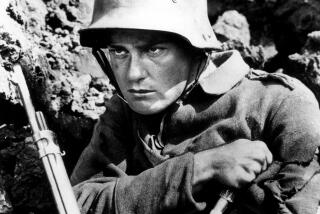The 7-hour ‘War’
If you’ve got the time, the Los Angeles County Museum of Art has the movie. The museum will screen the seven-hour 1968 Oscar-winning Russian film, “War and Peace,” in two parts Friday and Saturday evenings this month.
Produced by the then Soviet Union’s Mosfilm for a staggering $100 million -- somewhere near $700 million in today’s dollars -- the film, based on Leo Tolstoy’s seminal novel, is a sweeping epic filled with breathtaking battle scenes, beautiful costumes and sets and spectacular vistas. In Part 3, “The Battle of Borodino,” more than 100,000 real Soviet soldiers were used as extras.
Directed, co-adapted and starring Sergei Bondarchuk, “War and Peace” explores -- in a sometimes heavy-handed and confusing manner -- life, love and death among the Russian nobility before and after the Napoleonic Wars of the early 19th century. Bondarchuk plays Pierre Bezukgov, the awkward friend of the brave, stoic and handsome Prince Andrei, and Lyudmila Savelyeva is the beautiful Natasha.
LACMA is screening Mosfilm’s restored version of the film in Russian with English subtitles. The film was originally released in the U.S. with a poorly dubbed English soundtrack.
“There are numerous cuts of this film,” says Alla Verlotsky, president of Seagull Films, a New York-based programmer and distributor of Russian cinema. “One was the original release in Russia, which was the longest version. Another one they submitted for the Oscar and the third one was when it was released theatrically in the U.S. This isn’t the longest one, but not the shortest one.”
Though “War and Peace” was one of the first films in the Soviet Union to be shot in 70-millimeter -- called Sovscope 70 in the U.S. -- the restoration was done with 35mm materials. “I’m not sure what happened” to the 70mm version, says Verlotsky. “Unfortunately, after the collapse of the Soviet Union, everything collapsed -- including the film industry. There were a lot of economic hardships.”
Verlotsky says there were many reasons why the Soviet government approved the lavish Mosfilm production -- one is ideological. “When you talk about Russian literature, you talk about Tolstoy, Dostoevsky, Chekhov and Gogol,” she says. “ ‘War and Peace,’ of all the novels, is kind of the most beloved, the most patriotic and nationalistic in a positive way. Also, I think Soviet cinema, at that point especially, was looking up to Hollywood. Of course, this was kind of a Russian version of ‘Gone With the Wind,’ so I think they wanted very much to produce the biggest, the largest film, the greatest costume drama with battles.”
At the time of the production, Bondarchuk was the most respected film director in the country, says KCRW-FM art critic Edward Goldman, who emigrated from the Soviet Union 30 years ago. “Prior to ‘War and Peace,’ he won some international prizes for his movies. He had a very, very big influence and was on good terms with the Soviet authority,” Goldman says. And the Soviet authorities gave him anything he wanted. “Our understanding was when he needed thousands and thousands of soldiers, the government provided it for nothing,” says Goldman, who saw the film when it was released in the USSR.
“The budget was staggering,” he says. “But remember it was a very patriotic movie. I do remember conversations back then saying, ‘Boy, if Napoleon had the budget for this war that Bondarchuk had for his movies, the war would have ended up differently.’ ”
Verlotsky points out that despite Russia’s love affair with Bondarchuk, he wasn’t the greatest film director. “He has huge limitations,” she says, adding that his style was quite heavy-handed. “You definitely see there is no flow. I think the problem is, besides playing in it, he was directing it. But I think overall the film’s spectacular.”
--
More to Read
Only good movies
Get the Indie Focus newsletter, Mark Olsen's weekly guide to the world of cinema.
You may occasionally receive promotional content from the Los Angeles Times.











